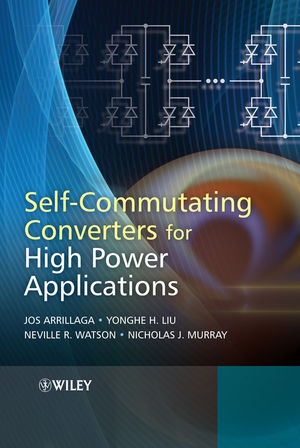Self-Commutating Converters for High Power ApplicationsISBN: 978-0-470-74682-0
Hardcover
324 pages
December 2009
 |
||||||
1 Introduction.
1.1 Early developments.
1.2 State of the large power semiconductor technology.
1.3 Voltage and current source conversion.
1.4 The pulse and level number concepts.
1.5 Line-commutated conversion (LCC).
1.6 Self-commutating conversion (SCC).
1.7 Concluding statement.
References.
2 Principles of Self-Commutating Conversion.
2.1 Introduction.
2.2 Basic VSC operation.
2.3 Main converter components.
2.4 Three-phase voltage source conversion.
2.5 Gate driving signal generation.
2.6 Space-vector PWM pattern.
2.7 Basic current source conversion operation.
2.8 Summary.
References.
3 Multilevel Voltage Source Conversion.
3.1 Introduction.
3.2 PWM-assisted multibridge conversion.
3.3 The diode clamping concept.
3.4 The flying capacitor concept.
3.5 Cascaded H-bridge configuration.
3.6 Modular multilevel conversion (MMC).
3.7 Summary.
References.
4 Multilevel Reinjection.
4.1 Introduction.
4.2 The reinjection concept in line-commutated current source conversion.
4.3 Application of the reinjection concept to self-commutating conversion.
4.4 Multilevel reinjection (MLR) – the waveforms.
4.5 MLR implementation – the combination concept.
4.6 MLR implementation – the distribution concept.
4.7 Summary.
References.
5 Modelling and Control of Converter Dynamics.
5.1 Introduction.
5.2 Control system levels.
5.3 Non-linearity of the power converter system.
5.4 Modelling the voltage source converter system.
5.5 Modelling grouped voltage source converters operating with fundamental frequency switching.
5.6 Modelling the current source converter system.
5.7 Modelling grouped current source converters with fundamental frequency switching.
5.8 Non-linear control of VSC and CSC systems.
5.9 Summary.
References.
6 PWM–HVDC Transmission.
6.1 Introduction.
6.2 State of the DC cable technology.
6.3 Basic self-commutating DC link structure.
6.4 Three-level PWM structure.
6.5 PWM–VSC control strategies.
6.6 DC link support during AC system disturbances.
6.7 Summary.
References.
7 Ultra High-Voltage VSC Transmission.
7.1 Introduction.
7.2 Modular multilevel conversion.
7.3 Multilevel H-bridge voltage reinjection.
7.4 Summary.
References.
8 Ultra High-Voltage Self-Commutating CSC Transmission.
8.1 Introduction.
8.2 MLCR-HVDC transmission.
8.3 Simulated performance under normal operation.
8.4 Simulated performance following disturbances.
8.5 Provision of independent reactive power control.
8.6 Summary.
References.
9 Back-to-Back Asynchronous Interconnection.
9.1 Introduction.
9.2 Provision of independent reactive power control.
9.3 MLCR back-to-back link.
9.4 Control system design.
9.5 Dynamic performance.
9.6 Waveform quality.
9.7 Summary.
References.
10 Low Voltage High DC Current AC–DC Conversion.
10.1 Introduction.
10.2 Present high current rectification technology.
10.3 Hybrid double-group configuration.
10.4 Centre-tapped rectifier option.
10.5 Two-quadrant MLCR rectification.
10.6 Parallel thyristor/MLCR rectification.
10.7 Multicell rectification with PWM control.
10.8 Summary.
References.
11 Power Conversion for High Energy Storage.
11.1 Introduction.
11.2 SMES technology.
11.3 Power conditioning.
11.4 The SMES coil.
11.5 MLCR current source converter based SMES power conditioning system.
11.6 Simulation verification.
11.7 Discussion – the future of SMES.
References.
Index.



